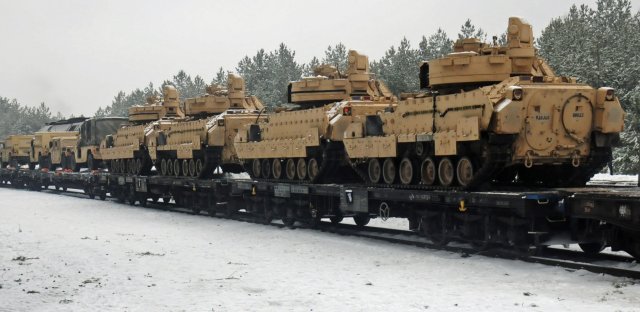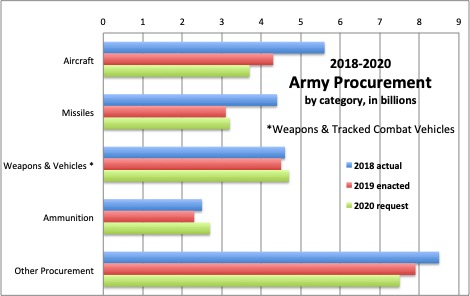Army Lumbers Into Future: $33B In 2020-2024 For Big 6, Eventually
Posted on

The Army has cut upgrades for its M2 Bradley troop carrier because it plans to replace it as soon as possible with a Next Generation Combat Vehicle.
UPDATE & CORRECTED with list of 31 priority programs PENTAGON: The Army’s five-year spending plan moves a whopping $32.8 billion from 186 cut or canceled programs to its Big Six modernization priorities, aimed at a future war with Russia or China. That’s well above what we were hearing just last month and 30 percent above the service’s original target of $25 billion.
[Click here for all our 2020 budget coverage]
But we’ll only see a modest down payment in the 2020 budget request. Most of the money is in the outyears, which means it may or may not ever happen. Over time, more and more of the “legacy” programs will go away as the new systems move from relatively inexpensive R&D to much more costly mass production, Undersecretary Ryan McCarthy said. For 2020, though,
- Army procurement is actually slightly down, from $22.1 billion in 2019 to $21.8 in 2020,
- Research, Development, Testing, & Evaluation (RDTE) is up, not quite as slightly, from $11.1 billion in ’19 to $12.2 in ’20.
- There’s a particularly strong spike in prototyping — aka Demonstration & Validation (Budget Activity 4) — which more than doubles, from $1.2 billion last year to $2.9 in the budget request. Earlier phases of RDTE, collectively called Science & Technology (S&T), stay effectively flat, while the phases that follow prototyping rise somewhat.
- Overall, Army modernization rises slightly, from $33 billion last year to $34 billion in the request. That’s still well below the recent peak of $37 billion back in 2018.
If my ground force friends will pardon a naval metaphor, the Army is like a big ship — an aircraft carrier, say, or maybe the Titanic — that takes a long, long time to turn around.
Today’s 2020 budget roll-out was painfully short on details, and no outyear figures came out at all, but we can see the shape of the future Army starting to emerge through the fog.
- As expected, the Army cuts upgrades of its venerable and increasingly overloaded M2 Bradley troop carrier, whose replacement is the first priority for the Next Generation Combat Vehicle program, the No. 2 priority of the Big Six.
- It also cuts production of the new turretless utility variant of the Bradley, the Armored Multi-Purpose Vehicle.
- It cuts the Avenger anti-aircraft vehicle — basically a Humvee with Stinger missiles — because the newer and more powerful Maneuver Short-Range Air Defense (MSHORAD) vehicle, a modified 8×8 Stryker, is about to enter service. Other Stryker variants are getting upgrades to their firepower and protection as well.
- The 2020 budget also cuts the Joint Light Tactical Vehicle, essentially a more survivable super-Humvee. I understand the planned Army-Marine buy of 50,000 JLTVs (over many years) is being reduced.
- Some upgrades to the Vietnam-vintage H-47 Chinook heavy lift helicopter continue, but I’ve been told the Army will only upgrade enough MH-47 variants for Special Operations and won’t purchase any CH-47 upgrades for the regular Army as originally planned. Count on Boeing to fight back on that.
- Meanwhile, an array of smart weapons programs — Hellfire missiles, Guided MLRS Rockets, and ATACMS — are being ramped up.
The Army was also able to provide me the top five programs outright cancelled in 2020, none of which will send tremendous shockwaves. They’re the HEMTT heavy truck and its Enhanced Container Handling unit (manufacturer Oshkosh has plenty of JLTV work); a landmine detection system known as FREHD; the High Explosive Guided Mortar; an aviation missing planning system called ADEC; and various modification programs to tactical vehicles, mine-protected vehicles, and mine-clearance vehicles.
UPDATE Army officials have variously referred to 30 or 31 priority programs. If you count individual budget line items, the total goes even higher, since a single priority might have multiple manifestations.
UPDATE CONTINUES An earlier version of the list included JLTV, which is notably absent here. But the Armored Multi-Purpose Vehicle is still included on the latest list, despite taking cuts in 2020. And unlike the Big Six themselves, broad categories which Army leaders have held inviolable, the list of specific programs is likely to fluctuate in the future.
UPDATE CONTINUES The 31 initiatives are grouped into eight clusters, corresponding to the Army Future Command’s eight high-level Cross Functional Teams. There’s one CFT for each of the Big Six priorities: in order, artillery, armored vehicles, aircraft, command networks, air & missile defense, and soldier gear. Then there are two more clusters for particularly tricky technical issues that warranted their own CFT-level attention: virtual/augmented reality training (an offshoot of the soldier equipment category, which it’s listed under) and Assured Position, Navigation, & Timing (APNT, basically alternatives to GPS, which is an offshoot of the network category).
CORRECTION The original version of this list counted 32 items, but we were over by one: I’d included something called “Non-System Training Devices – Engineering Development,” which is actually a bit of budget terminology about how certain initiatives could be funded, not an initiative in itself. The list below and the text of this article are now correct.
Army 30-Plus Priorities – Revised by BreakingDefense on Scribd
Just to complicate the picture further, the Army’s real budget request for 2020, counting both the base budget and what’s been shunted to the Overseas Contingency Operations (OCO) account, totals $182.3 billion. But the administration has parked another $9.2 billion in “emergency funds” in the Army budget: $2 billion to repair Marine Corps and Air Force bases damaged in hurricanes this year, $7.2 billion set aside to directly or indirectly fund President Trump’s border wall.
Subscribe to our newsletter
Promotions, new products and sales. Directly to your inbox.



